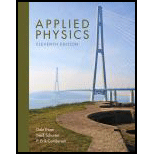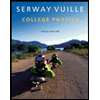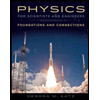
Applied Physics (11th Edition)
11th Edition
ISBN: 9780134159386
Author: Dale Ewen, Neill Schurter, Erik Gundersen
Publisher: PEARSON
expand_more
expand_more
format_list_bulleted
Concept explainers
Textbook Question
Chapter 3.2, Problem 13P
Make a sketch of each vector in standard position. Use the scale 1.0 cm = 1
13. C = 25 m at 245º
Expert Solution & Answer
Want to see the full answer?
Check out a sample textbook solution
Students have asked these similar questions
Find the Resultant Vector of the following vectors using Analytical method and polygon method.
1. 10m, E2. 15m,80 S of W
Draw and label the vector 2A snd the vector 1/2A
Find a vector (v) with an initial point <-5,-5,-4> and a terminal point of <4,-10,4>. Then find a unit vector in the direction of vector v. Give the answer in i, j, k format
Vector v = ?
Unit vector = ?
Chapter 3 Solutions
Applied Physics (11th Edition)
Ch. 3.1 - Using the scale 1.0 cm = 50km, find the length of...Ch. 3.1 - Using the scale 1.0 cm = 50km, find the length of...Ch. 3.1 - Using the scale 1.0 cm = 50km, find the length of...Ch. 3.1 - Using the scale 1.0 cm = 50km, find the length of...Ch. 3.1 - Using the scale 1.0 cm = 50km, find the length of...Ch. 3.1 - Using the scale 1.0 cm = 50km, find the length of...Ch. 3.1 - Draw the vectors in Problems 1 through 6 using the...Ch. 3.1 - Draw the vectors in Problems 1 through 6 using the...Ch. 3.1 - Draw the vectors in Problems 1 through 6 using the...Ch. 3.1 - Draw the vectors in Problems 1 through 6 using the...
Ch. 3.1 - Draw the vectors in Problems 1 through 6 using the...Ch. 3.1 - Draw the vectors in Problems 1 through 6 using the...Ch. 3.1 - Using the scale 14 in. = 20 mi, find the length of...Ch. 3.1 - Using the scale 14 in. = 20 mi, find the length of...Ch. 3.1 - Using the scale 14 in. = 20 mi, find the length of...Ch. 3.1 - Using the scale 14 in. = 20 mi, find the length of...Ch. 3.1 - Using the scale 14 in. = 20 mi, find the length of...Ch. 3.1 - Using the scale 14 in. = 20 mi, find the length of...Ch. 3.1 - Draw the vectors in Problems 13 through 18 using...Ch. 3.1 - Draw the vectors in Problems 13 through 18 using...Ch. 3.1 - Draw the vectors in Problems 13 through 18 using...Ch. 3.1 - Draw the vectors in Problems 13 through 18 using...Ch. 3.1 - Draw the vectors in Problems 13 through 18 using...Ch. 3.1 - Draw the vectors in Problems 13 through 18 using...Ch. 3.2 - Find the x- and y-components of each vector in the...Ch. 3.2 - Find the x- and y-components of each vector in the...Ch. 3.2 - Find the x- and y-components of each vector in the...Ch. 3.2 - Find the x- and y-components of each vector in the...Ch. 3.2 - Find the x- and y-components of each vector in the...Ch. 3.2 - Find the x- and y-components of each vector in the...Ch. 3.2 - Find the x- and y-components of each vector in the...Ch. 3.2 - Find the x- and y-components of each vector in the...Ch. 3.2 - Find the x- and y-components of each vector in the...Ch. 3.2 - Find the x- and y-components of each vector in the...Ch. 3.2 - Make a sketch of each vector in standard position....Ch. 3.2 - Make a sketch of each vector in standard position....Ch. 3.2 - Make a sketch of each vector in standard position....Ch. 3.2 - Make a sketch of each vector in standard position....Ch. 3.2 - Make a sketch of each vector in standard position....Ch. 3.2 - Make a sketch of each vector in standard position....Ch. 3.2 - Make a sketch of each vector in standard position....Ch. 3.2 - Make a sketch of each vector in standard position....Ch. 3.2 - Find the x- and y- components of each vector. 19.Ch. 3.2 - Find the x- and y- components of each vector. 20.Ch. 3.2 - Find the x- and y- components of each vector. 21.Ch. 3.2 - Find the x- and y- components of each vector. 22.Ch. 3.2 - Find the x- and y- components of each vector. 23.Ch. 3.2 - Find the x- and y- components of each vector. 24.Ch. 3.2 - Find the x- and y-components of each vector given...Ch. 3.2 - Find the x- and y-components of each vector given...Ch. 3.2 - Find the x- and y-components of each vector given...Ch. 3.2 - Find the x- and y-components of each vector given...Ch. 3.2 - Find the x- and y-components of each vector given...Ch. 3.2 - Find the x- and y-components of each vector given...Ch. 3.3 - Use graph paper to find the resultant of each...Ch. 3.3 - Use graph paper to find the resultant of each...Ch. 3.3 - Use graph paper to find the resultant of each...Ch. 3.3 - Use graph paper to find the resultant of each...Ch. 3.3 - Use graph paper to find the resultant of each...Ch. 3.3 - Use graph paper to find the resultant of each...Ch. 3.3 - Use graph paper to find the resultant of each...Ch. 3.3 - Use graph paper to find the resultant of each...Ch. 3.3 - Use graph paper to find the resultant of each...Ch. 3.3 - Use graph paper to find the resultant or each...Ch. 3.3 - Use graph paper to find the resultant or each...Ch. 3.3 - Use graph paper to find the resultant of each...Ch. 3.3 - Use graph paper to find the resultant of each...Ch. 3.3 - Use graph paper to find the resultant of each...Ch. 3.3 - Find the x- and y- components of each resultant...Ch. 3.3 - Find the x- and y- components of each resultant...Ch. 3.3 - Find the x- and y- components of each resultant...Ch. 3.3 - Find the x- and y- components of each resultant...Ch. 3.3 - Find the x- and y- components of each resultant...Ch. 3.3 - Find the x- and y- components of each resultant...Ch. 3.3 - Find the x- and y- components of each resultant...Ch. 3.3 - Find the x- and y- components of each resultant...Ch. 3.3 - Find the x- and y- components of each resultant...Ch. 3.3 - Find the x- and y- components of each resultant...Ch. 3.3 - For each set of vectors, graph and find the x- and...Ch. 3.3 - For each set of vectors, graph and find the x- and...Ch. 3.3 - For each set of vectors, graph and find the x- and...Ch. 3.3 - For each set of vectors, graph and find the x- and...Ch. 3.3 - For each set of vectors, graph and find the x- and...Ch. 3.3 - For each set of vectors, graph and find the x- and...Ch. 3.3 - In Problems 31 through 42, find each resultant...Ch. 3.3 - In Problems 31 through 42, find each resultant...Ch. 3.3 - In Problems 31 through 42, find each resultant...Ch. 3.3 - In Problems 31 through 42, find each resultant...Ch. 3.3 - In Problems 31 through 42, find each resultant...Ch. 3.3 - In Problems 31 through 42, rind each resultant...Ch. 3.3 - In Problems 31 through 42, find each resultant...Ch. 3.3 - In Problems 31 through 42, find each resultant...Ch. 3.3 - In Problems 31 through 42, find each resultant...Ch. 3.3 - In Problems 31 through 42, find each resultant...Ch. 3.3 - In Problems 31 through 42, find each resultant...Ch. 3.3 - In Problems 31 through 42, find each resultant...Ch. 3.3 - A road grader must go around a pond by traveling...Ch. 3.3 - An earthmover must go north 350 m and then west...Ch. 3.3 - An airplane takes off and flies 225 km on a course...Ch. 3.3 - A ship travels 50.0 mi on a course of 15.0 south...Ch. 3.3 - A ship travels 135 km from port on a course of...Ch. 3.3 - A ship travels 145 km from port on a course of...Ch. 3 - Displacement a. can be interchanged with...Ch. 3 - When adding vectors, the order in which they are...Ch. 3 - A vector is in standard position when its initial...Ch. 3 - Discuss number plane, origin, and axis in your own...Ch. 3 - Can every vector be described in terms of its...Ch. 3 - Describe how to add two or more vectors...Ch. 3 - Describe how to find a resultant vector if given...Ch. 3 - Is a vector limited to a single position in the...Ch. 3 - Is the angle of a vector in standard position...Ch. 3 - What are the limits on the angle measure of a...Ch. 3 - Describe how to find the x- and y-components of a...Ch. 3 - Describe how to find a vector in standard position...Ch. 3 - Find the x- and y-components of vector R, which...Ch. 3 - Find the x- and y-components of vector R, which...Ch. 3 - Find the x- and y-components of vector R, which...Ch. 3 - Vector R has length 9.00 cm at 240.0. Find its x-...Ch. 3 - Vector R has length 9.00 cm at 40.0. Find its x-...Ch. 3 - Vector R has length 18.0 cm at 305.0. Find its x-...Ch. 3 - A hiker is plotting his course on a map with a...Ch. 3 - A hiker is plotting his course on a map with a...Ch. 3 - A co-pilot is charting her course on a map with a...Ch. 3 - A co-pilot is charting her course on a map with a...Ch. 3 - Vector R has x-component = +14.0 and y-component =...Ch. 3 - Vector R has x-component = -5.00 and y-component =...Ch. 3 - Vector R has x-component = +8.00 and y-component =...Ch. 3 - Vector R has x-component = -3.00 and y-component =...Ch. 3 - Vectors A, B, and C are given. Vector A has...Ch. 3 - Vectors A, B, and C are given. Vector A has...Ch. 3 - Vectors A, B. and C are given. Vector A has...Ch. 3 - Vectors A, B, and C are given. Vector A has...Ch. 3 - Graph and find x- and y-components of each...Ch. 3 - Graph and find the x- and y-components of each...Ch. 3 - An airplane takes off and flies 245 km on a course...Ch. 3 - A ship travels 155 km from port on a course of...Ch. 3 - The New Clark Bridge is an elegant cable-stayed...Ch. 3 - Frank just learned that the 800-m section of...Ch. 3 - Power cables need to be suspended by the power...Ch. 3 - With the airplane cruising at 30,000 ft, the...
Additional Science Textbook Solutions
Find more solutions based on key concepts
28.74 Long, straight conductors with square cross section, each carrying current I, are laid side by side to fo...
University Physics (14th Edition)
Consider the following discussion between two students about the cause of the seasons.
Student 1: I get it. So ...
Lecture- Tutorials for Introductory Astronomy
Your 200-g cup of tea is boiling-hot. About how much ice should you add to bring it down to a comfortable sippi...
An Introduction to Thermal Physics
31. A parallel-plate air capacitor has a capacitance of 500.0 pF and a charge of magnitude 0.200 μC on each pla...
College Physics (10th Edition)
95. In answer to the question "What keeps Earth moving around the Sun?" a friend asserts that inertia keeps it ...
Conceptual Physical Science (6th Edition)
Knowledge Booster
Learn more about
Need a deep-dive on the concept behind this application? Look no further. Learn more about this topic, physics and related others by exploring similar questions and additional content below.Similar questions
- Given A = <1.2,-2,-1.2> and B = <-4.5,0.3,6.2> If VectorC=B−A/2 , determine the magnitude of vector C. (Round your answers to 4 decimal places.)arrow_forwardVector lies in the xy plane. Both of its components will be negative if it points from the origin into which quadrant? (a) the first quadrant (b) the second quadrant (c) the third quadrant (d) the fourth quadrant (e) the second or fourth quadrantsarrow_forwardVector A has a magnitude of 4.50 m and makes an angle of 64.0 with the positive x axis. Vector B, with a magnitude equal to that of vector A, points along the negative y axis (Fig. P3.16). Graphically find the magnitude and direction of the resultant vector a. A+B, b. AB, c. BA, and d. 2AB.arrow_forward
- Calculate the resultant vector of the following using the Pythagorean theorem and graphical method. (a) 5 meters north and 4 meters eastarrow_forward1. Find the resultant vector of the three vectors. Given: first vector=270 N along the x-axis, second vector= 230 N at 37.2°, and third vector=142 N at 30° 2. Consider two vectors of the same magnitude. Each is pointing at opposite directions. The resultant vector will have a magnitude of _________?arrow_forwardFor the given vectors:a.) Find the resultantb.) Find the A - C using the triangle methodc.) Find the vector product B x Dd.) Find the vector product D x Aarrow_forward
- Please use vector addition! :D Will thumbs up if correctarrow_forwardFind the resultant of the following vectors using the analytical method 2. Vector A: 10N, -35° Vector B: 5N, 45° Vector C: 1N, 85°arrow_forwardplease solve for 2 you don't have to place the vectors, only i=use the measurementsarrow_forward
- What are the components of the following vector? R= 300.0 N @ 20.0 degrees above the negative x- axisarrow_forwardVector A is 30° below the x-axis. Vector B is 35° to the right of the negative y-axis. You will be asked to find the resultant, R = A + B. How do you calculate the x-components of each vector?arrow_forwardThe figure shows three vectors. Vector A→ has a length of 35.0, vector B→ has a length of 69.0, and vector C→ has a length of 21.0. Solve the given equations. A→∙B→= ? B→∙(A→+C→)= ?arrow_forward
arrow_back_ios
SEE MORE QUESTIONS
arrow_forward_ios
Recommended textbooks for you
 College PhysicsPhysicsISBN:9781285737027Author:Raymond A. Serway, Chris VuillePublisher:Cengage Learning
College PhysicsPhysicsISBN:9781285737027Author:Raymond A. Serway, Chris VuillePublisher:Cengage Learning Physics for Scientists and Engineers: Foundations...PhysicsISBN:9781133939146Author:Katz, Debora M.Publisher:Cengage Learning
Physics for Scientists and Engineers: Foundations...PhysicsISBN:9781133939146Author:Katz, Debora M.Publisher:Cengage Learning Physics for Scientists and Engineers, Technology ...PhysicsISBN:9781305116399Author:Raymond A. Serway, John W. JewettPublisher:Cengage Learning
Physics for Scientists and Engineers, Technology ...PhysicsISBN:9781305116399Author:Raymond A. Serway, John W. JewettPublisher:Cengage Learning

College Physics
Physics
ISBN:9781285737027
Author:Raymond A. Serway, Chris Vuille
Publisher:Cengage Learning

Physics for Scientists and Engineers: Foundations...
Physics
ISBN:9781133939146
Author:Katz, Debora M.
Publisher:Cengage Learning

Physics for Scientists and Engineers, Technology ...
Physics
ISBN:9781305116399
Author:Raymond A. Serway, John W. Jewett
Publisher:Cengage Learning
Introduction to Vectors and Their Operations; Author: Professor Dave Explains;https://www.youtube.com/watch?v=KBSCMTYaH1s;License: Standard YouTube License, CC-BY